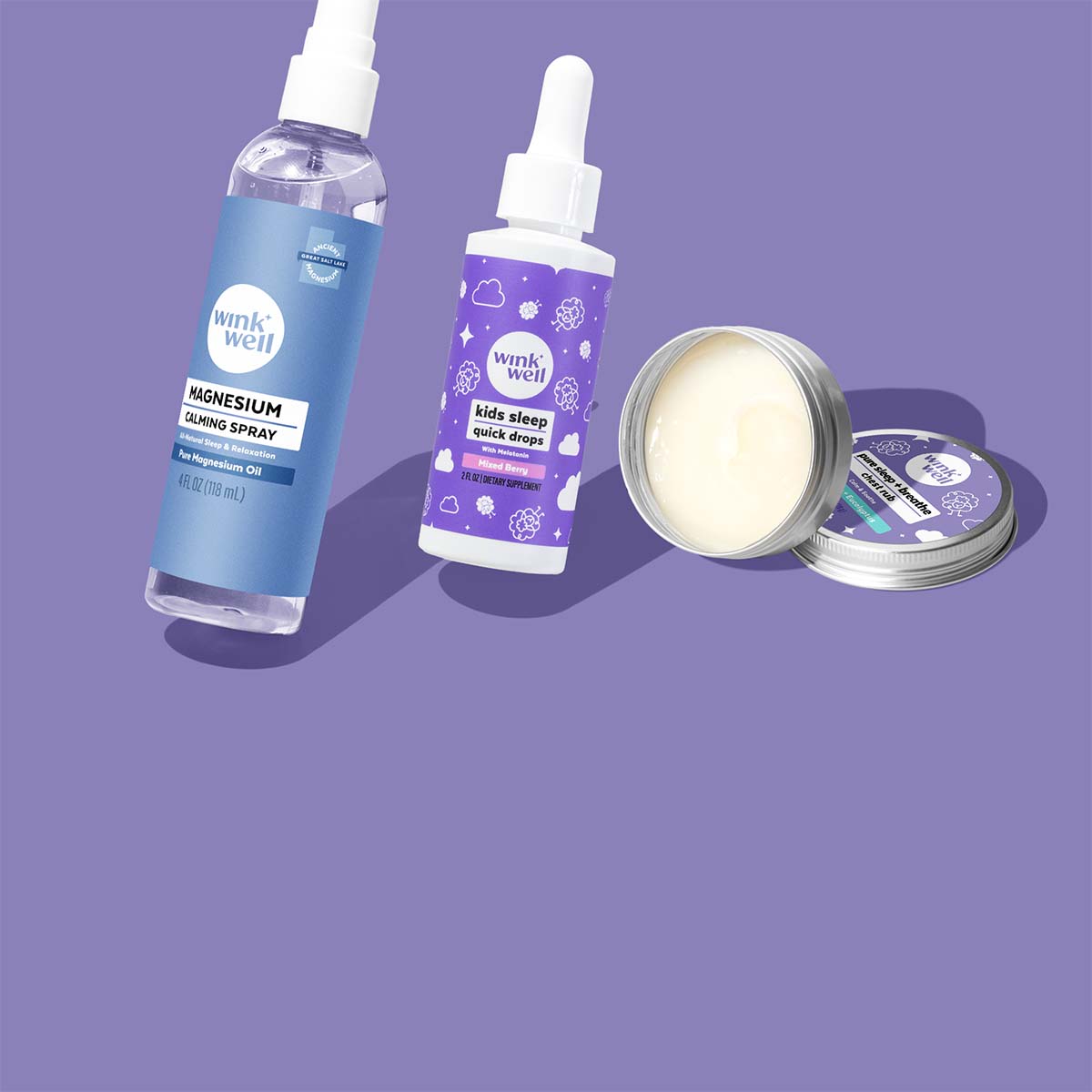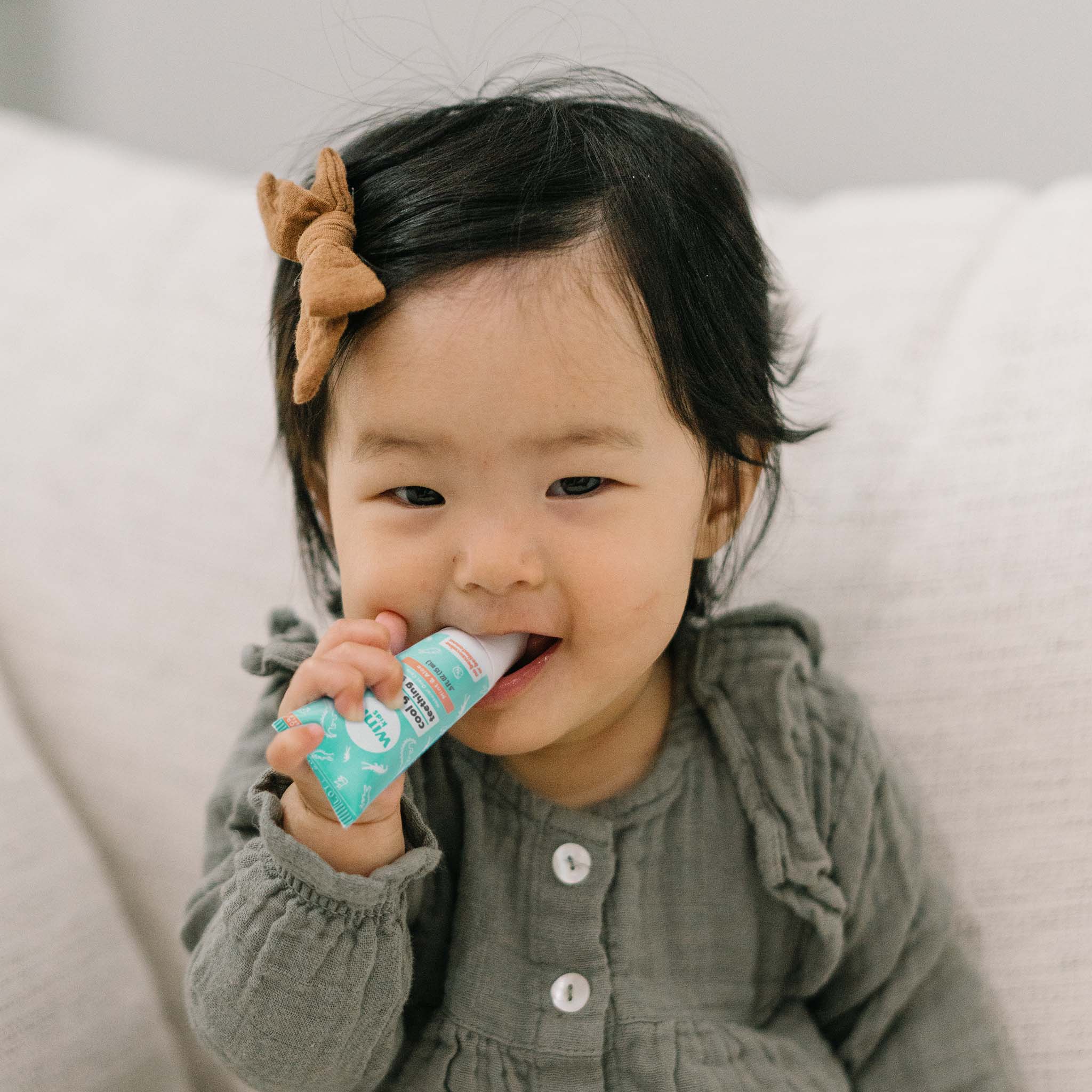Written by Chelsea Spooner
If you are a first time mom, or it’s been a minute since you have had a teething baby, you might be feeling unsure or intimidated by the whole teething process. But rest assured, by the end of this guide you will be a pro and feel confident in what’s to come. After you have implemented these 7 Steps we promise you will thrive during your little one’s teething journey.
Step 1. Determine that they are, in fact, teething.
This first step is really important because oftentimes common teething symptoms can be confused for things like sickness, growth spurt or a sleep regression. Here are 6 things to keep in mind when determining if your little one is teething.
- A. Take a look at their gums. When a tooth is getting ready to appear your baby’s gums might look puffy or bruised. You might also be able to see a tiny white speck or nub on their gums. It might shock you when you feel around your baby’s mouth with your finger to find a tooth that is already erupting.
- Fussiness/Irritability (especially at night). This could be your first clue that they might be teething because babies tend to experience more teething action at night. Teething can start just about whenever (babies can even be born with teeth) but it tends to align with normal sleep regression times (4 months, 6 months, etc.).
- Less interested in solids. If you have ever had a toothache, you know how painful it can be to chew. This may be the reason you see your little one pulling back when it comes to solids. If they are resisting solids don’t worry, simply offer them their normal feedings (bottle or nursing) to ensure they stay hydrated. Again, that pain won’t last forever.
- Notice any chomping, biting or sucking. You might notice your little one chomping on your fingers, toys, clothing, just about anything they can put in their mouth. They do this to help relieve the pressure of whatever is happening in their mouth.
- Lots and lots of drool. It’s normal for your baby to drool, in fact around 3 months is when their salivary glands develop, but you might notice your baby is like a running faucet. We are talking about wardrobe changes because there is so much drool. Don’t assume that your baby is teething just because of drooling, but keep an eye out for drooling in combination with other symptoms. Make sure to wipe their mouth gently so that they don’t develop a rash around their mouth and face.
- Diaper Rash. Check their diapers. While teething doesn’t directly cause a diaper rash, infants who are teething and drooling a lot tend to swallow more saliva that can result in a looser stool which can lead to diaper rashes more frequently.

Step 2. Keep it Cool…Don’t numb
Cooling off those gums is a great way to combat the discomfort your little one may be feeling. Here are 3 different ways to give them instant relief.
- Start by taking a clean washcloth and submerge it in water, wring it out until just damp, and place it in the fridge on a clean surface. Once cool, fold it and give it to your baby to chew on (while supervised!) to relieve those sore gums. Be careful not to freeze the cloth solid as that can be too hard for the gums and be painful.
- Another spin on this is to take a cloth and tie a knot in one corner and dip that corner in breastmilk or formula so when it is frozen (not solid) it tastes good. Next, wring it out and place it in a ziplock bag. Stick it in your freezer for 20-30 minutes. Remember, we want it nice and cold, not frozen.
- Silicone teething ring (put in the fridge only). Silicone rings can be helpful because they are mess free and easy to grab for your little ones. Just remember to keep them in the fridge only, not frozen.
Step 3. Provide comfort at night.
Babies often feel the brunt of their teething pain at night. And while teething can last between 5 to 30 months of age, that does not mean your little one will be in pain the whole time. The actual PAIN associated with teething only lasts for about 24-72 hours prior to the tooth eruption. Once the tooth is through the gum, most of the pain is gone. Teeth can move up and down over a 1-8 day period but again that pain window is a lot smaller than we think. So let’s get you prepared to help your little one when they really need it most! Here’s how to help them during the evening.
- Offer comfort. The best thing you can do when they wake at night is offer them comfort. This could be holding, rocking, nursing/feeding, a special toy/blanket, baby wearing etc. Or even just giving them some extra cuddle time can make the world of difference. Teething can be confusing for your little one. They don’t know why they’re in pain so giving them love and being patient when they are fussy is what they need.
- Massage those gums. Take a clean finger and apply some gentle pressure on their little gums. This may seem like something simple but it can be really helpful.
- Offer toys for chewing. Similar to the pressure that would come from your finger offering a toy to chew on allows them to get some relief. Here are some of our favorites.
- Cool to soothe the gums. The combination of cold and pressure can be a huge relief for your little one. Offer them something cold like a washcloth or silicone toy or that has been in the fridge. (Refer back to step 2 “Keep it Cool” for more ideas). Remember, don’t numb the gums with numbing gels or tablets. This causes choking and gagging and is dangerous for your baby
- Stay consistent. A key piece of providing comfort is staying consistent with sleep when you can. Keep their bedtime routine calm and relaxing to help them feel safe. Keeping your little one's routine as close to normal as possible will be beneficial in the long run. It is definitely acceptable to offer them comfort while they are in pain during that rough 24-72 hour “pain period” but bounce right back into consistent naps, bedtimes so as to not create bad sleep habits.
- Turn on a white noise or sound machine. Turning up the noise can create a nice distraction for your little one. Anything that can help take their attention away from the pain they are feeling is a win.
- Give your child a foot rub. Research has shown that there is a connection between toes and teeth! This is a great way to distract your baby and keep the focus on their toes. Massaging on either side of the toes as well as above the nail bed on the big toe will have an amazing response. To massage a specific point, the solar plexus, stay in the center, right underneath the ball of the foot. Try using a lotion while massaging to induce a sense of calmness and relaxation.
- Wipe away the drool. Wiping away the drool will help them feel more comfortable and help prevent any type of rash from forming. It can also prevent dry or itchy skin.
- Stay calm. Children are very sensitive and good at picking up on your emotions, especially stress. With that being said, try your best to stay calm. Try singing songs or using soothing phrases. Remember, they’re experiencing pain and discomfort and need lots of love!

Step 4. Treats and Snacks that provide comfort & cooling
This is a great way to help keep your little one comfortable and pleasantly distracted. Here are some foods you can offer to them during the teething process.
- Watermelon: This one is perfect for teething because it is generally loved by all kids, and it is soft and cold making it easy to munch on. As an added benefit – don’t cut the rind off. It is totally edible and is the perfect thing to gnaw on while teething. It is also strong enough that you don’t have to worry about them taking bites that are too big.
- Fruit slices: Fruit, overall, makes a great comfort tool. Try freezing bananas, strawberries and more. You can put them in a silicone holder that allows babies to safely chew and bite without getting big chunks.
- Frozen bagel or waffle. Th is trick provides a soft and yummy way to calm those sore gums and a way for them to continue eating. (Use this appropriately according to their age and what foods they are able to chew).
- Smoothie purees. Try making your favorite smoothie and freezing it in an ice cube or popsicle tray. Once frozen enough to hold solid, give it to your little one in a silicone holder or just with their hands to munch on.
- Pineapple ring. This is exactly what it sounds like. Cut the pineapple into a ring and freeze it just enough to stay in tack while your little one is biting it. This is a sweet treat and a great way for them to get relief.
- Homemade pops (try breast milk). Similar to the smoothie purees, try freezing your breastmilk in an ice cube or popsicle tray to create another way to soothe your little ones gums and have it taste great.
- Teething crackers. These crackers are soft and do not crack or crumble. Instead they dissolve as your baby gums them. These are a safe and effective way to help your baby deal with the pain of teething. Your baby's sore gums are stimulated and soothed as they gum the cracker and gnaw at it with their teeth.
Step 5. Be aware of these products. Safety first!
- Topical gels: DO NOT USE Benzocaine gels. Numbing gels contain benzocaine which is not safe for children and has been linked to death in infants. It is not safe because it can cause methemoglobinemia, a serious condition in which the amount of oxygen carried through the blood is greatly reduced. Numbing the mouth is NOT something you want to do either. If a child's mouth is numb it can make it hard to swallow their own saliva and can result in gagging, choking or difficulty swallowing.
- Teething tablets: Another teething aid that might seem harmless but can contain very scary ingredients is Teething Tablets. Many teething tablets claim to be homeopathic or natural and are actually unsafe. Some tablets contain Belladonna, which is toxic in high enough amounts. In other words, we do not want to be putting this in our babies mouths.
- Teething necklaces: Have you seen those cute amber teething necklaces? Maybe your friend has raved about them and you’ve been tempted to try. Well, it's extremely important to note that the FDA issued a warning against these in 2018 for several reasons. For one, the beads can break off and create a choking hazard. Two, the necklace can get caught on something and restrict your child's breathing. They can and have caused choking, strangulation and death.
- Frozen teething rings: Normally, you associate all things frozen to be good to soothe those tender gums but these teething rings can become over-frozen and therefore are too hard for your baby's gums. Instead of being soothing and helpful these frozen rings can cause harm and damage sensitive gums.
Step 6. Distract and soothe.
You might feel out of options after looking at the list above, but don’t worry we can help. Since 2017, Wink has been helping thousands of parents with their teething babies.
What products can you use and WHY is it safe?
- Wink Cool Gums Teething Gel: Wink created a gel specifically for your little ones that is designed to cool and soothe, not numb.* (Remember, any type of numbing is not safe). This doctor-developed formula is natural and 100% drug-free. It does not contain harmful ingredients like belladonna or benzocaine which were mentioned above. It also doesn’t contain clove oil or lidocaine, or anything else potentially toxic and harmful to babies and children).
Pro tip, try putting it in the fridge to give an extra cool sensation.
- Something cold: This could be a cloth, silicone teething ring (put in the fridge only), frozen purees, frozen waffle or bagel.
- Massage: Using a clean finger gently massaging the gums for a minute or two can help relieve discomfort.
- Warm Bath. Draw a warm bath for your little one. The warm water can soothe their body and provide a fun distraction from the discomfort they are feeling.
- Pain Reliever: Your pediatrician may recommend giving your child a pain reliever. Make sure to follow the dosing guidelines for your child's age and weight. Take caution to not mix or cocktail medications.
Step 7. Be Patient and Know You’re a good mama.
No really! You’re an amazing mother. The fact you’re learning more about your baby and trying to help them is proof! Take it easy on yourself. You have almost made it! However, this last step might be the most important. Be patient. Teething is a natural process and the goal is to help your teething baby with the discomfort they are feeling. We know it may be frustrating, and when you are in the depths of it, teething can feel like it lasts forever. But, just know, after implementing this guide you are doing all you can for your little one. And remember, you are not alone! We’re here to help! If you have any questions, please call us, we will be happy to answer any questions for you. 888-799-5656
When a tooth is trying to pop through you can expect the timeframe to be about 8 days.
That includes 4 days before and 3 days after the tooth comes through the gum. But, thankfully, they will only usually feel pain for 24-72 hrs during the actual eruption phase.
Here are our top 3 favorite teething products:
- Cool Gums Teething Gel: This is a Wink staple! Cool Gums Gel is designed to cool and soothe NOT numb. It has menthol and peppermint that is properly diluted and 100% safe for oral consumption in babies, children, and adults. Along with soothing and cooling this can be used as a training toothpaste!
- Chest Rub: This product contains eucalyptus and lavender oils to help promote calm and peaceful sleep. It is made with coconut oil, shea butter, and natural oils. Chest rub is great for sleep training, soothing and calming babies and is the perfect addition to your bedtime routine.
- Llama Lotion: For those baby foot and back massages that help calm and soothe your little one. This lotion is gentle, non-greasy and so so perfect for when your baby needs that extra love.
Still have questions? Let us know!







Leave a comment
All comments are moderated before being published.
This site is protected by hCaptcha and the hCaptcha Privacy Policy and Terms of Service apply.